Critical Review of Three Peer-Reviewed Qualitative Journal Articles on Public Health
VerifiedAdded on 2023/06/07
|10
|2376
|458
AI Summary
This study conducts a critical review of three peer-reviewed qualitative journal articles with a particular focus on public health. The articles critiqued were under the overall subject of public health but with varying topics such as health beliefs in relation to lifestyle diseases, lifestyle interventions on chronic diseases and perceptions of patients diagnosed with chronic illness.
Contribute Materials
Your contribution can guide someone’s learning journey. Share your
documents today.

Running head: Public Health 1
Public Health
By:
Student ID:
Course No:
Tutor:
Date:
Public Health
By:
Student ID:
Course No:
Tutor:
Date:
Secure Best Marks with AI Grader
Need help grading? Try our AI Grader for instant feedback on your assignments.
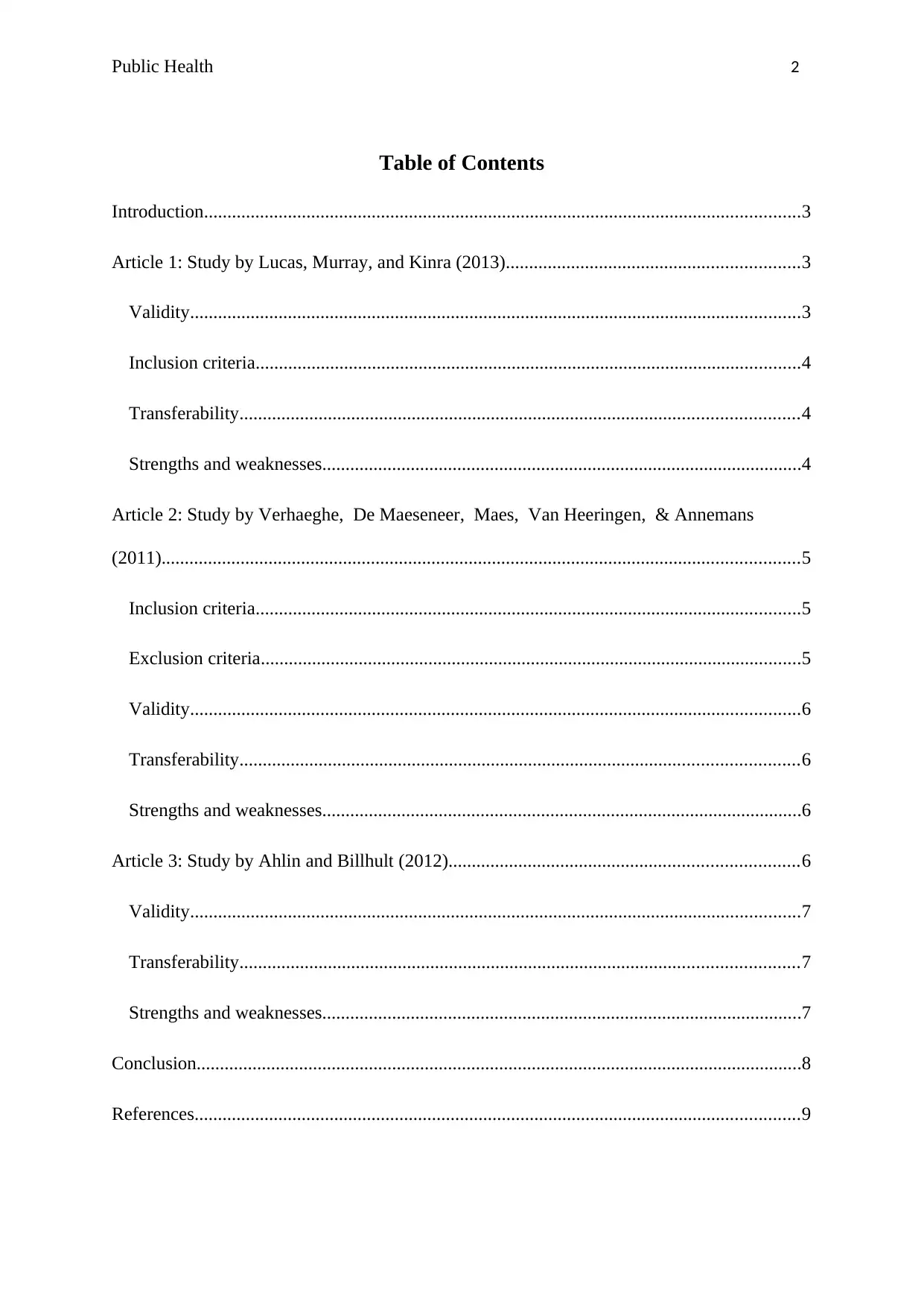
Public Health 2
Table of Contents
Introduction................................................................................................................................3
Article 1: Study by Lucas, Murray, and Kinra (2013)...............................................................3
Validity...................................................................................................................................3
Inclusion criteria.....................................................................................................................4
Transferability........................................................................................................................4
Strengths and weaknesses.......................................................................................................4
Article 2: Study by Verhaeghe, De Maeseneer, Maes, Van Heeringen, & Annemans
(2011).........................................................................................................................................5
Inclusion criteria.....................................................................................................................5
Exclusion criteria....................................................................................................................5
Validity...................................................................................................................................6
Transferability........................................................................................................................6
Strengths and weaknesses.......................................................................................................6
Article 3: Study by Ahlin and Billhult (2012)...........................................................................6
Validity...................................................................................................................................7
Transferability........................................................................................................................7
Strengths and weaknesses.......................................................................................................7
Conclusion..................................................................................................................................8
References..................................................................................................................................9
Table of Contents
Introduction................................................................................................................................3
Article 1: Study by Lucas, Murray, and Kinra (2013)...............................................................3
Validity...................................................................................................................................3
Inclusion criteria.....................................................................................................................4
Transferability........................................................................................................................4
Strengths and weaknesses.......................................................................................................4
Article 2: Study by Verhaeghe, De Maeseneer, Maes, Van Heeringen, & Annemans
(2011).........................................................................................................................................5
Inclusion criteria.....................................................................................................................5
Exclusion criteria....................................................................................................................5
Validity...................................................................................................................................6
Transferability........................................................................................................................6
Strengths and weaknesses.......................................................................................................6
Article 3: Study by Ahlin and Billhult (2012)...........................................................................6
Validity...................................................................................................................................7
Transferability........................................................................................................................7
Strengths and weaknesses.......................................................................................................7
Conclusion..................................................................................................................................8
References..................................................................................................................................9
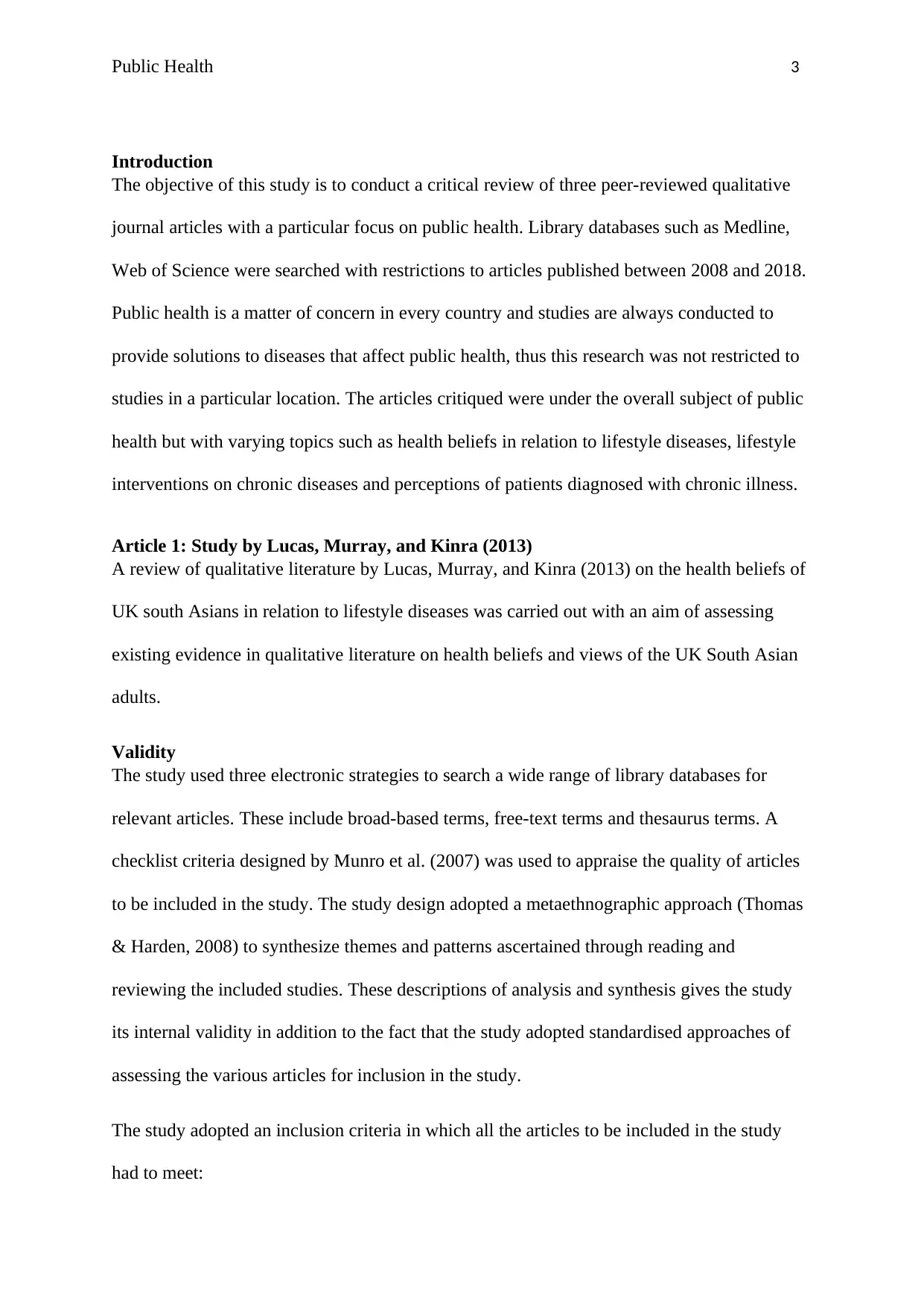
Public Health 3
Introduction
The objective of this study is to conduct a critical review of three peer-reviewed qualitative
journal articles with a particular focus on public health. Library databases such as Medline,
Web of Science were searched with restrictions to articles published between 2008 and 2018.
Public health is a matter of concern in every country and studies are always conducted to
provide solutions to diseases that affect public health, thus this research was not restricted to
studies in a particular location. The articles critiqued were under the overall subject of public
health but with varying topics such as health beliefs in relation to lifestyle diseases, lifestyle
interventions on chronic diseases and perceptions of patients diagnosed with chronic illness.
Article 1: Study by Lucas, Murray, and Kinra (2013)
A review of qualitative literature by Lucas, Murray, and Kinra (2013) on the health beliefs of
UK south Asians in relation to lifestyle diseases was carried out with an aim of assessing
existing evidence in qualitative literature on health beliefs and views of the UK South Asian
adults.
Validity
The study used three electronic strategies to search a wide range of library databases for
relevant articles. These include broad-based terms, free-text terms and thesaurus terms. A
checklist criteria designed by Munro et al. (2007) was used to appraise the quality of articles
to be included in the study. The study design adopted a metaethnographic approach (Thomas
& Harden, 2008) to synthesize themes and patterns ascertained through reading and
reviewing the included studies. These descriptions of analysis and synthesis gives the study
its internal validity in addition to the fact that the study adopted standardised approaches of
assessing the various articles for inclusion in the study.
The study adopted an inclusion criteria in which all the articles to be included in the study
had to meet:
Introduction
The objective of this study is to conduct a critical review of three peer-reviewed qualitative
journal articles with a particular focus on public health. Library databases such as Medline,
Web of Science were searched with restrictions to articles published between 2008 and 2018.
Public health is a matter of concern in every country and studies are always conducted to
provide solutions to diseases that affect public health, thus this research was not restricted to
studies in a particular location. The articles critiqued were under the overall subject of public
health but with varying topics such as health beliefs in relation to lifestyle diseases, lifestyle
interventions on chronic diseases and perceptions of patients diagnosed with chronic illness.
Article 1: Study by Lucas, Murray, and Kinra (2013)
A review of qualitative literature by Lucas, Murray, and Kinra (2013) on the health beliefs of
UK south Asians in relation to lifestyle diseases was carried out with an aim of assessing
existing evidence in qualitative literature on health beliefs and views of the UK South Asian
adults.
Validity
The study used three electronic strategies to search a wide range of library databases for
relevant articles. These include broad-based terms, free-text terms and thesaurus terms. A
checklist criteria designed by Munro et al. (2007) was used to appraise the quality of articles
to be included in the study. The study design adopted a metaethnographic approach (Thomas
& Harden, 2008) to synthesize themes and patterns ascertained through reading and
reviewing the included studies. These descriptions of analysis and synthesis gives the study
its internal validity in addition to the fact that the study adopted standardised approaches of
assessing the various articles for inclusion in the study.
The study adopted an inclusion criteria in which all the articles to be included in the study
had to meet:
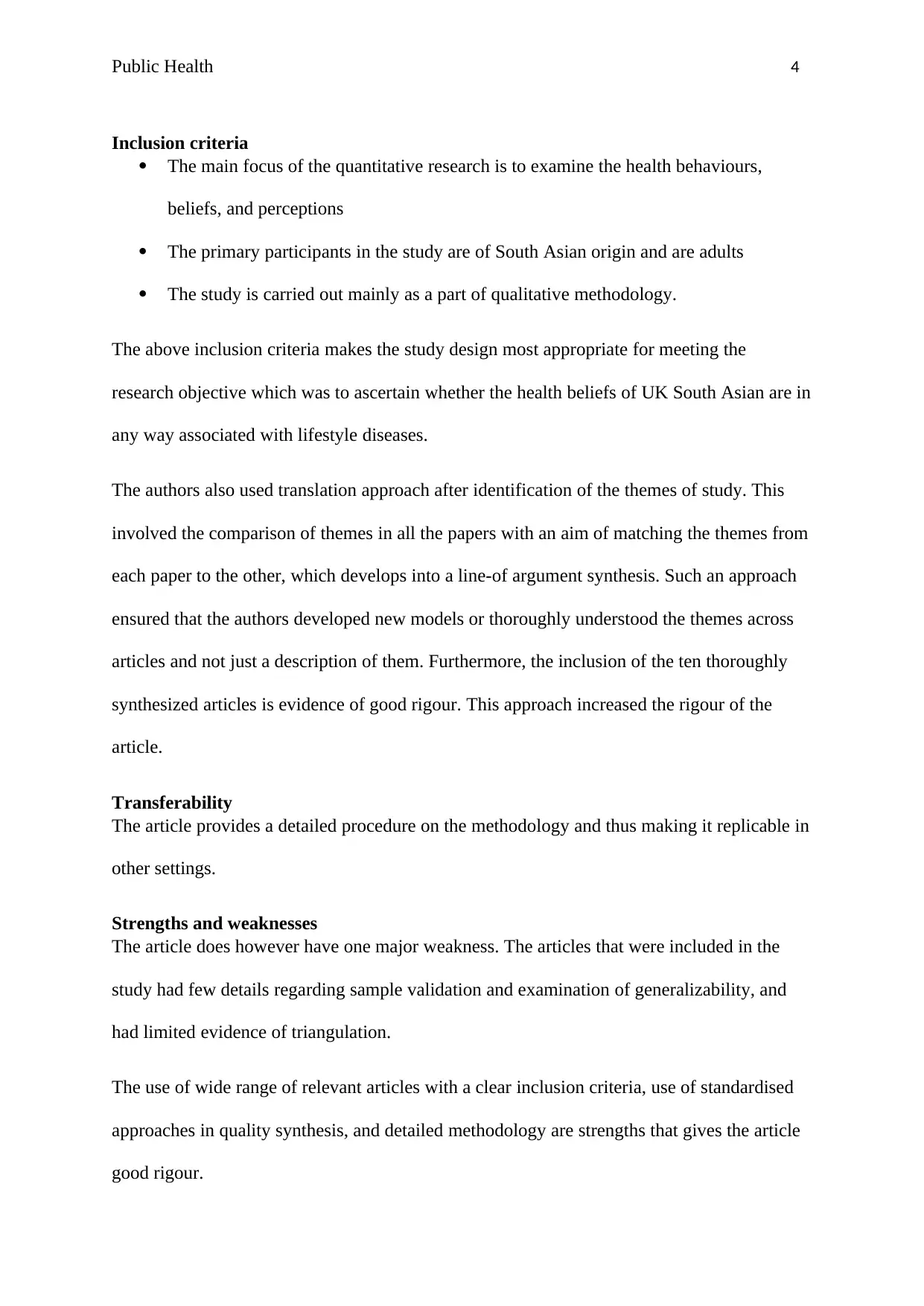
Public Health 4
Inclusion criteria
The main focus of the quantitative research is to examine the health behaviours,
beliefs, and perceptions
The primary participants in the study are of South Asian origin and are adults
The study is carried out mainly as a part of qualitative methodology.
The above inclusion criteria makes the study design most appropriate for meeting the
research objective which was to ascertain whether the health beliefs of UK South Asian are in
any way associated with lifestyle diseases.
The authors also used translation approach after identification of the themes of study. This
involved the comparison of themes in all the papers with an aim of matching the themes from
each paper to the other, which develops into a line-of argument synthesis. Such an approach
ensured that the authors developed new models or thoroughly understood the themes across
articles and not just a description of them. Furthermore, the inclusion of the ten thoroughly
synthesized articles is evidence of good rigour. This approach increased the rigour of the
article.
Transferability
The article provides a detailed procedure on the methodology and thus making it replicable in
other settings.
Strengths and weaknesses
The article does however have one major weakness. The articles that were included in the
study had few details regarding sample validation and examination of generalizability, and
had limited evidence of triangulation.
The use of wide range of relevant articles with a clear inclusion criteria, use of standardised
approaches in quality synthesis, and detailed methodology are strengths that gives the article
good rigour.
Inclusion criteria
The main focus of the quantitative research is to examine the health behaviours,
beliefs, and perceptions
The primary participants in the study are of South Asian origin and are adults
The study is carried out mainly as a part of qualitative methodology.
The above inclusion criteria makes the study design most appropriate for meeting the
research objective which was to ascertain whether the health beliefs of UK South Asian are in
any way associated with lifestyle diseases.
The authors also used translation approach after identification of the themes of study. This
involved the comparison of themes in all the papers with an aim of matching the themes from
each paper to the other, which develops into a line-of argument synthesis. Such an approach
ensured that the authors developed new models or thoroughly understood the themes across
articles and not just a description of them. Furthermore, the inclusion of the ten thoroughly
synthesized articles is evidence of good rigour. This approach increased the rigour of the
article.
Transferability
The article provides a detailed procedure on the methodology and thus making it replicable in
other settings.
Strengths and weaknesses
The article does however have one major weakness. The articles that were included in the
study had few details regarding sample validation and examination of generalizability, and
had limited evidence of triangulation.
The use of wide range of relevant articles with a clear inclusion criteria, use of standardised
approaches in quality synthesis, and detailed methodology are strengths that gives the article
good rigour.
Secure Best Marks with AI Grader
Need help grading? Try our AI Grader for instant feedback on your assignments.
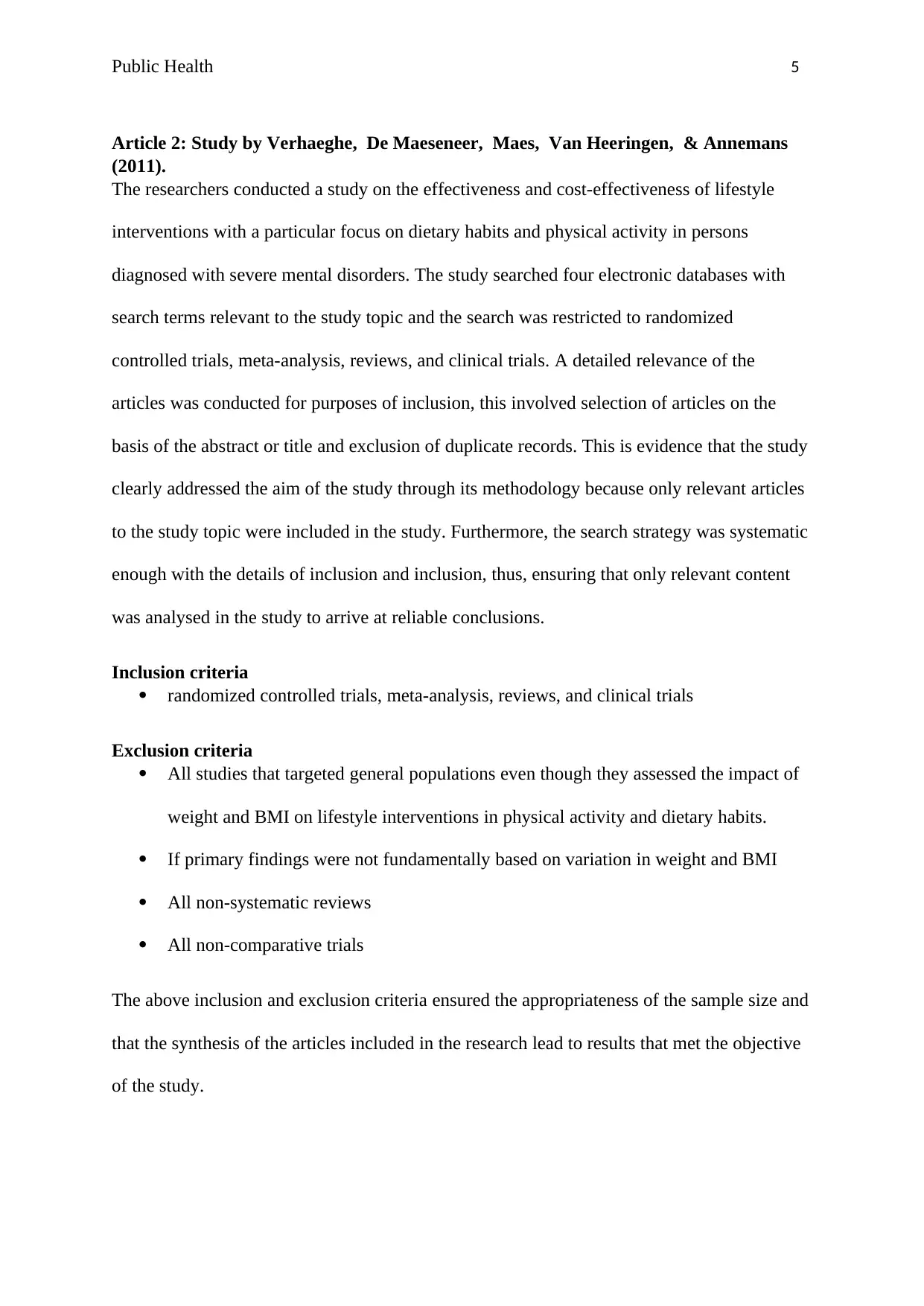
Public Health 5
Article 2: Study by Verhaeghe, De Maeseneer, Maes, Van Heeringen, & Annemans
(2011).
The researchers conducted a study on the effectiveness and cost-effectiveness of lifestyle
interventions with a particular focus on dietary habits and physical activity in persons
diagnosed with severe mental disorders. The study searched four electronic databases with
search terms relevant to the study topic and the search was restricted to randomized
controlled trials, meta-analysis, reviews, and clinical trials. A detailed relevance of the
articles was conducted for purposes of inclusion, this involved selection of articles on the
basis of the abstract or title and exclusion of duplicate records. This is evidence that the study
clearly addressed the aim of the study through its methodology because only relevant articles
to the study topic were included in the study. Furthermore, the search strategy was systematic
enough with the details of inclusion and inclusion, thus, ensuring that only relevant content
was analysed in the study to arrive at reliable conclusions.
Inclusion criteria
randomized controlled trials, meta-analysis, reviews, and clinical trials
Exclusion criteria
All studies that targeted general populations even though they assessed the impact of
weight and BMI on lifestyle interventions in physical activity and dietary habits.
If primary findings were not fundamentally based on variation in weight and BMI
All non-systematic reviews
All non-comparative trials
The above inclusion and exclusion criteria ensured the appropriateness of the sample size and
that the synthesis of the articles included in the research lead to results that met the objective
of the study.
Article 2: Study by Verhaeghe, De Maeseneer, Maes, Van Heeringen, & Annemans
(2011).
The researchers conducted a study on the effectiveness and cost-effectiveness of lifestyle
interventions with a particular focus on dietary habits and physical activity in persons
diagnosed with severe mental disorders. The study searched four electronic databases with
search terms relevant to the study topic and the search was restricted to randomized
controlled trials, meta-analysis, reviews, and clinical trials. A detailed relevance of the
articles was conducted for purposes of inclusion, this involved selection of articles on the
basis of the abstract or title and exclusion of duplicate records. This is evidence that the study
clearly addressed the aim of the study through its methodology because only relevant articles
to the study topic were included in the study. Furthermore, the search strategy was systematic
enough with the details of inclusion and inclusion, thus, ensuring that only relevant content
was analysed in the study to arrive at reliable conclusions.
Inclusion criteria
randomized controlled trials, meta-analysis, reviews, and clinical trials
Exclusion criteria
All studies that targeted general populations even though they assessed the impact of
weight and BMI on lifestyle interventions in physical activity and dietary habits.
If primary findings were not fundamentally based on variation in weight and BMI
All non-systematic reviews
All non-comparative trials
The above inclusion and exclusion criteria ensured the appropriateness of the sample size and
that the synthesis of the articles included in the research lead to results that met the objective
of the study.
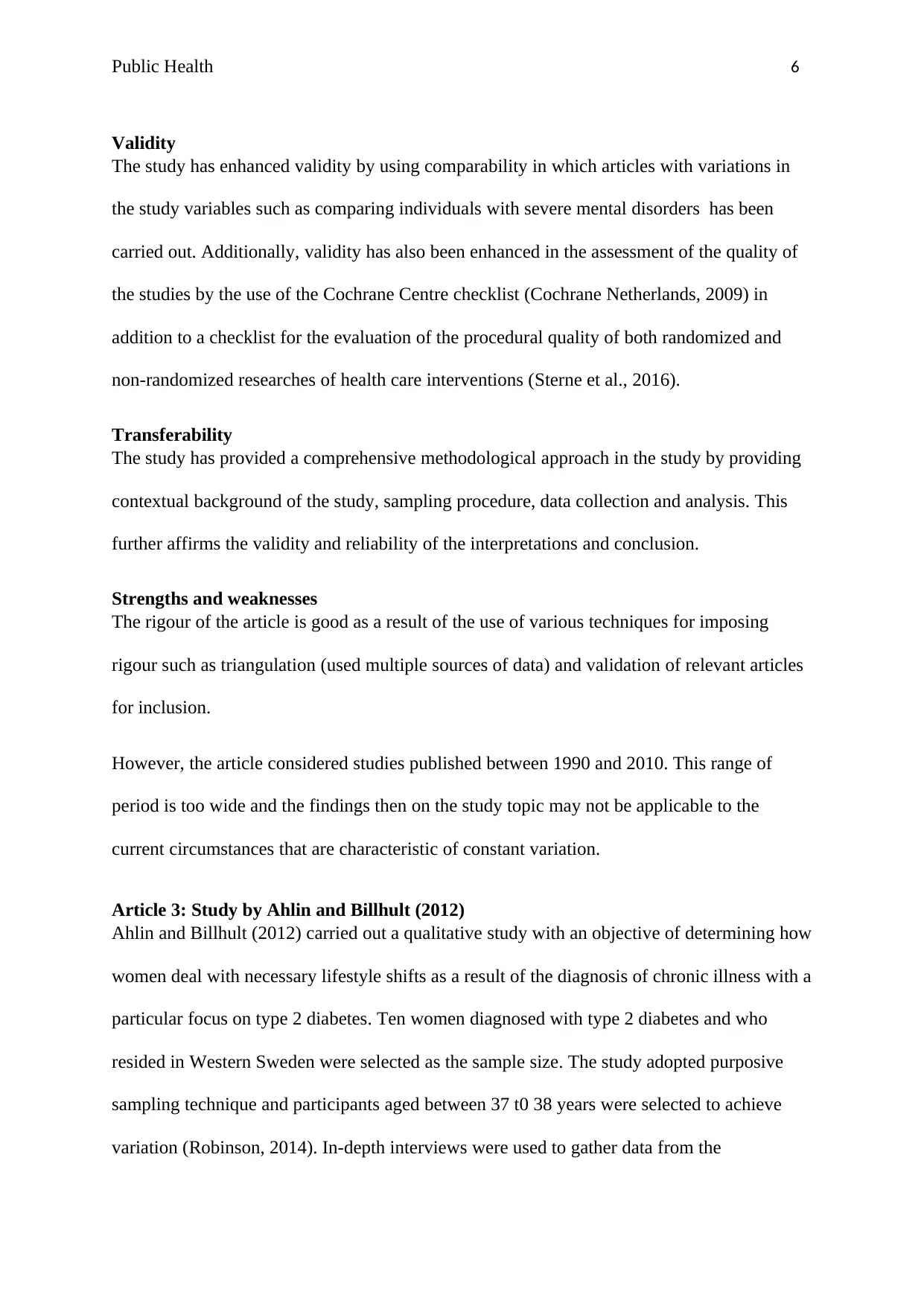
Public Health 6
Validity
The study has enhanced validity by using comparability in which articles with variations in
the study variables such as comparing individuals with severe mental disorders has been
carried out. Additionally, validity has also been enhanced in the assessment of the quality of
the studies by the use of the Cochrane Centre checklist (Cochrane Netherlands, 2009) in
addition to a checklist for the evaluation of the procedural quality of both randomized and
non-randomized researches of health care interventions (Sterne et al., 2016).
Transferability
The study has provided a comprehensive methodological approach in the study by providing
contextual background of the study, sampling procedure, data collection and analysis. This
further affirms the validity and reliability of the interpretations and conclusion.
Strengths and weaknesses
The rigour of the article is good as a result of the use of various techniques for imposing
rigour such as triangulation (used multiple sources of data) and validation of relevant articles
for inclusion.
However, the article considered studies published between 1990 and 2010. This range of
period is too wide and the findings then on the study topic may not be applicable to the
current circumstances that are characteristic of constant variation.
Article 3: Study by Ahlin and Billhult (2012)
Ahlin and Billhult (2012) carried out a qualitative study with an objective of determining how
women deal with necessary lifestyle shifts as a result of the diagnosis of chronic illness with a
particular focus on type 2 diabetes. Ten women diagnosed with type 2 diabetes and who
resided in Western Sweden were selected as the sample size. The study adopted purposive
sampling technique and participants aged between 37 t0 38 years were selected to achieve
variation (Robinson, 2014). In-depth interviews were used to gather data from the
Validity
The study has enhanced validity by using comparability in which articles with variations in
the study variables such as comparing individuals with severe mental disorders has been
carried out. Additionally, validity has also been enhanced in the assessment of the quality of
the studies by the use of the Cochrane Centre checklist (Cochrane Netherlands, 2009) in
addition to a checklist for the evaluation of the procedural quality of both randomized and
non-randomized researches of health care interventions (Sterne et al., 2016).
Transferability
The study has provided a comprehensive methodological approach in the study by providing
contextual background of the study, sampling procedure, data collection and analysis. This
further affirms the validity and reliability of the interpretations and conclusion.
Strengths and weaknesses
The rigour of the article is good as a result of the use of various techniques for imposing
rigour such as triangulation (used multiple sources of data) and validation of relevant articles
for inclusion.
However, the article considered studies published between 1990 and 2010. This range of
period is too wide and the findings then on the study topic may not be applicable to the
current circumstances that are characteristic of constant variation.
Article 3: Study by Ahlin and Billhult (2012)
Ahlin and Billhult (2012) carried out a qualitative study with an objective of determining how
women deal with necessary lifestyle shifts as a result of the diagnosis of chronic illness with a
particular focus on type 2 diabetes. Ten women diagnosed with type 2 diabetes and who
resided in Western Sweden were selected as the sample size. The study adopted purposive
sampling technique and participants aged between 37 t0 38 years were selected to achieve
variation (Robinson, 2014). In-depth interviews were used to gather data from the
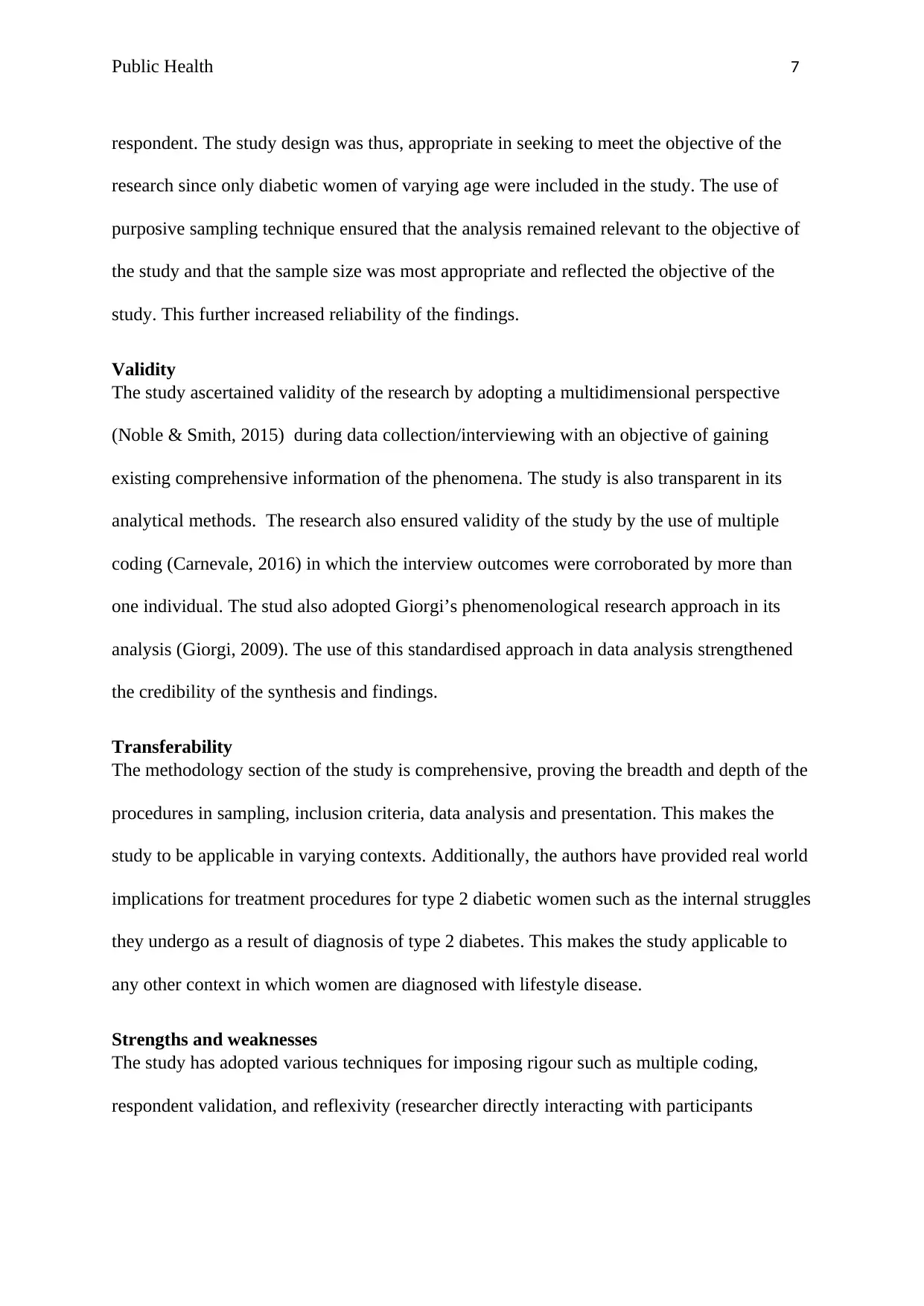
Public Health 7
respondent. The study design was thus, appropriate in seeking to meet the objective of the
research since only diabetic women of varying age were included in the study. The use of
purposive sampling technique ensured that the analysis remained relevant to the objective of
the study and that the sample size was most appropriate and reflected the objective of the
study. This further increased reliability of the findings.
Validity
The study ascertained validity of the research by adopting a multidimensional perspective
(Noble & Smith, 2015) during data collection/interviewing with an objective of gaining
existing comprehensive information of the phenomena. The study is also transparent in its
analytical methods. The research also ensured validity of the study by the use of multiple
coding (Carnevale, 2016) in which the interview outcomes were corroborated by more than
one individual. The stud also adopted Giorgi’s phenomenological research approach in its
analysis (Giorgi, 2009). The use of this standardised approach in data analysis strengthened
the credibility of the synthesis and findings.
Transferability
The methodology section of the study is comprehensive, proving the breadth and depth of the
procedures in sampling, inclusion criteria, data analysis and presentation. This makes the
study to be applicable in varying contexts. Additionally, the authors have provided real world
implications for treatment procedures for type 2 diabetic women such as the internal struggles
they undergo as a result of diagnosis of type 2 diabetes. This makes the study applicable to
any other context in which women are diagnosed with lifestyle disease.
Strengths and weaknesses
The study has adopted various techniques for imposing rigour such as multiple coding,
respondent validation, and reflexivity (researcher directly interacting with participants
respondent. The study design was thus, appropriate in seeking to meet the objective of the
research since only diabetic women of varying age were included in the study. The use of
purposive sampling technique ensured that the analysis remained relevant to the objective of
the study and that the sample size was most appropriate and reflected the objective of the
study. This further increased reliability of the findings.
Validity
The study ascertained validity of the research by adopting a multidimensional perspective
(Noble & Smith, 2015) during data collection/interviewing with an objective of gaining
existing comprehensive information of the phenomena. The study is also transparent in its
analytical methods. The research also ensured validity of the study by the use of multiple
coding (Carnevale, 2016) in which the interview outcomes were corroborated by more than
one individual. The stud also adopted Giorgi’s phenomenological research approach in its
analysis (Giorgi, 2009). The use of this standardised approach in data analysis strengthened
the credibility of the synthesis and findings.
Transferability
The methodology section of the study is comprehensive, proving the breadth and depth of the
procedures in sampling, inclusion criteria, data analysis and presentation. This makes the
study to be applicable in varying contexts. Additionally, the authors have provided real world
implications for treatment procedures for type 2 diabetic women such as the internal struggles
they undergo as a result of diagnosis of type 2 diabetes. This makes the study applicable to
any other context in which women are diagnosed with lifestyle disease.
Strengths and weaknesses
The study has adopted various techniques for imposing rigour such as multiple coding,
respondent validation, and reflexivity (researcher directly interacting with participants
Paraphrase This Document
Need a fresh take? Get an instant paraphrase of this document with our AI Paraphraser
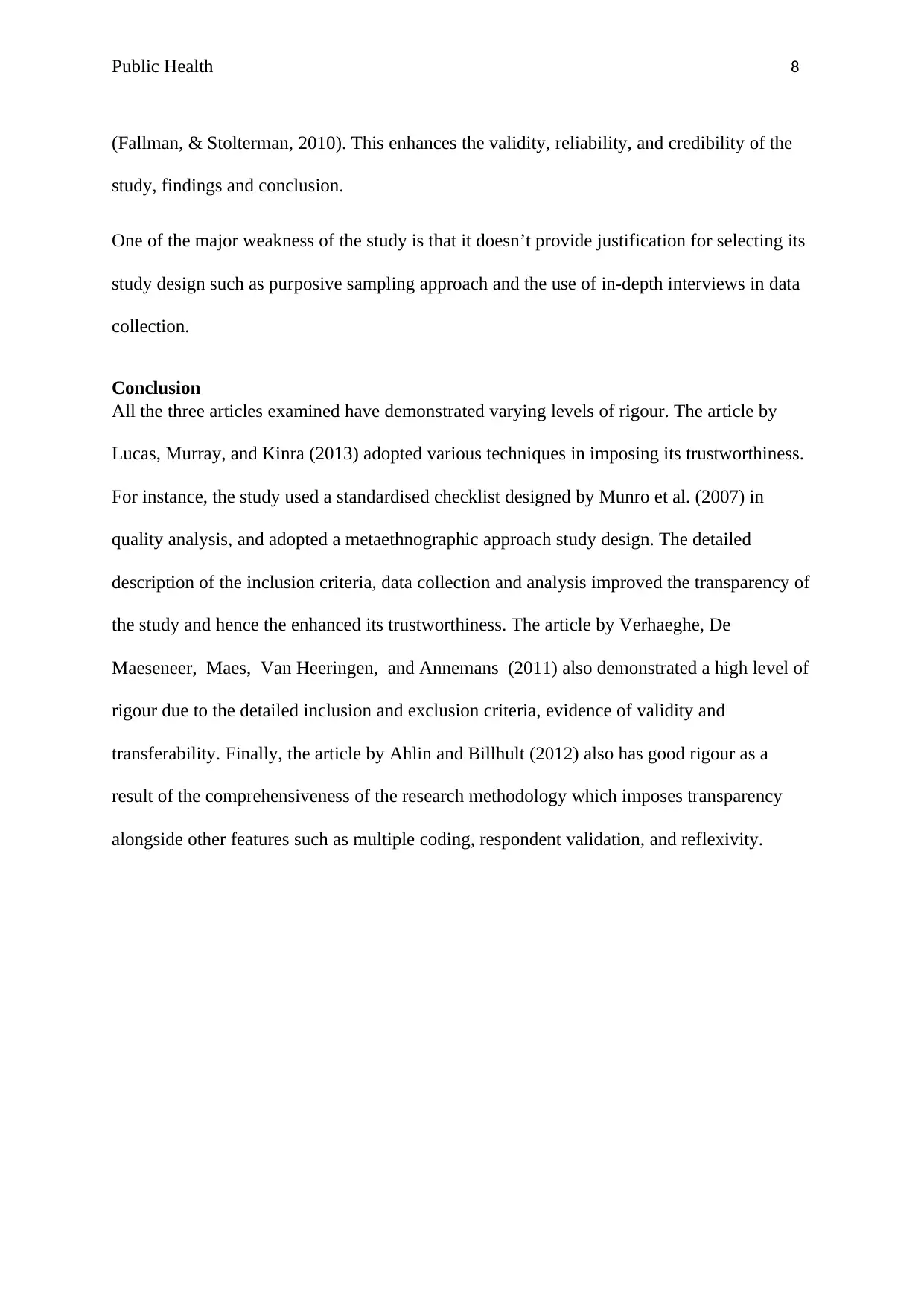
Public Health 8
(Fallman, & Stolterman, 2010). This enhances the validity, reliability, and credibility of the
study, findings and conclusion.
One of the major weakness of the study is that it doesn’t provide justification for selecting its
study design such as purposive sampling approach and the use of in-depth interviews in data
collection.
Conclusion
All the three articles examined have demonstrated varying levels of rigour. The article by
Lucas, Murray, and Kinra (2013) adopted various techniques in imposing its trustworthiness.
For instance, the study used a standardised checklist designed by Munro et al. (2007) in
quality analysis, and adopted a metaethnographic approach study design. The detailed
description of the inclusion criteria, data collection and analysis improved the transparency of
the study and hence the enhanced its trustworthiness. The article by Verhaeghe, De
Maeseneer, Maes, Van Heeringen, and Annemans (2011) also demonstrated a high level of
rigour due to the detailed inclusion and exclusion criteria, evidence of validity and
transferability. Finally, the article by Ahlin and Billhult (2012) also has good rigour as a
result of the comprehensiveness of the research methodology which imposes transparency
alongside other features such as multiple coding, respondent validation, and reflexivity.
(Fallman, & Stolterman, 2010). This enhances the validity, reliability, and credibility of the
study, findings and conclusion.
One of the major weakness of the study is that it doesn’t provide justification for selecting its
study design such as purposive sampling approach and the use of in-depth interviews in data
collection.
Conclusion
All the three articles examined have demonstrated varying levels of rigour. The article by
Lucas, Murray, and Kinra (2013) adopted various techniques in imposing its trustworthiness.
For instance, the study used a standardised checklist designed by Munro et al. (2007) in
quality analysis, and adopted a metaethnographic approach study design. The detailed
description of the inclusion criteria, data collection and analysis improved the transparency of
the study and hence the enhanced its trustworthiness. The article by Verhaeghe, De
Maeseneer, Maes, Van Heeringen, and Annemans (2011) also demonstrated a high level of
rigour due to the detailed inclusion and exclusion criteria, evidence of validity and
transferability. Finally, the article by Ahlin and Billhult (2012) also has good rigour as a
result of the comprehensiveness of the research methodology which imposes transparency
alongside other features such as multiple coding, respondent validation, and reflexivity.
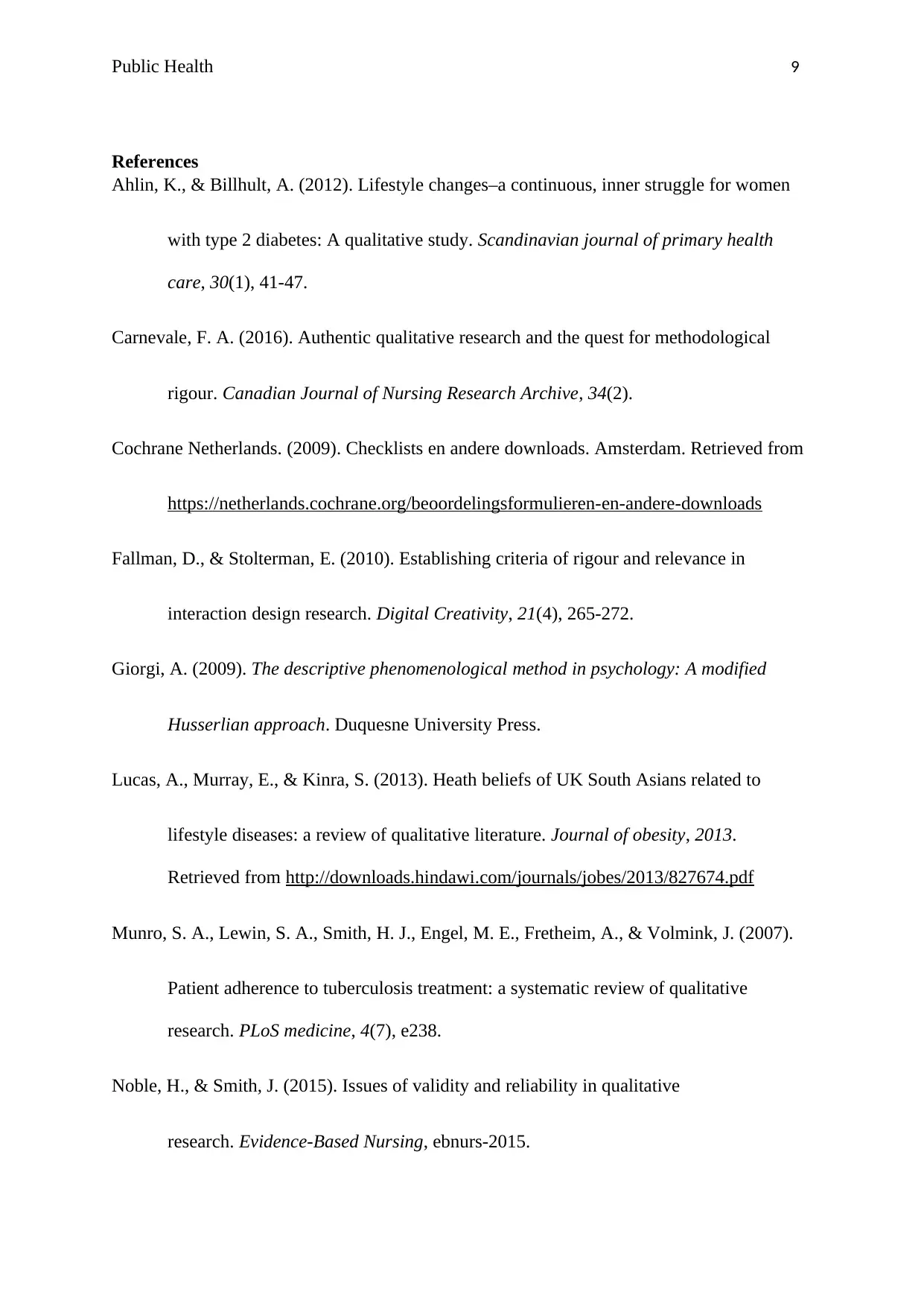
Public Health 9
References
Ahlin, K., & Billhult, A. (2012). Lifestyle changes–a continuous, inner struggle for women
with type 2 diabetes: A qualitative study. Scandinavian journal of primary health
care, 30(1), 41-47.
Carnevale, F. A. (2016). Authentic qualitative research and the quest for methodological
rigour. Canadian Journal of Nursing Research Archive, 34(2).
Cochrane Netherlands. (2009). Checklists en andere downloads. Amsterdam. Retrieved from
https://netherlands.cochrane.org/beoordelingsformulieren-en-andere-downloads
Fallman, D., & Stolterman, E. (2010). Establishing criteria of rigour and relevance in
interaction design research. Digital Creativity, 21(4), 265-272.
Giorgi, A. (2009). The descriptive phenomenological method in psychology: A modified
Husserlian approach. Duquesne University Press.
Lucas, A., Murray, E., & Kinra, S. (2013). Heath beliefs of UK South Asians related to
lifestyle diseases: a review of qualitative literature. Journal of obesity, 2013.
Retrieved from http://downloads.hindawi.com/journals/jobes/2013/827674.pdf
Munro, S. A., Lewin, S. A., Smith, H. J., Engel, M. E., Fretheim, A., & Volmink, J. (2007).
Patient adherence to tuberculosis treatment: a systematic review of qualitative
research. PLoS medicine, 4(7), e238.
Noble, H., & Smith, J. (2015). Issues of validity and reliability in qualitative
research. Evidence-Based Nursing, ebnurs-2015.
References
Ahlin, K., & Billhult, A. (2012). Lifestyle changes–a continuous, inner struggle for women
with type 2 diabetes: A qualitative study. Scandinavian journal of primary health
care, 30(1), 41-47.
Carnevale, F. A. (2016). Authentic qualitative research and the quest for methodological
rigour. Canadian Journal of Nursing Research Archive, 34(2).
Cochrane Netherlands. (2009). Checklists en andere downloads. Amsterdam. Retrieved from
https://netherlands.cochrane.org/beoordelingsformulieren-en-andere-downloads
Fallman, D., & Stolterman, E. (2010). Establishing criteria of rigour and relevance in
interaction design research. Digital Creativity, 21(4), 265-272.
Giorgi, A. (2009). The descriptive phenomenological method in psychology: A modified
Husserlian approach. Duquesne University Press.
Lucas, A., Murray, E., & Kinra, S. (2013). Heath beliefs of UK South Asians related to
lifestyle diseases: a review of qualitative literature. Journal of obesity, 2013.
Retrieved from http://downloads.hindawi.com/journals/jobes/2013/827674.pdf
Munro, S. A., Lewin, S. A., Smith, H. J., Engel, M. E., Fretheim, A., & Volmink, J. (2007).
Patient adherence to tuberculosis treatment: a systematic review of qualitative
research. PLoS medicine, 4(7), e238.
Noble, H., & Smith, J. (2015). Issues of validity and reliability in qualitative
research. Evidence-Based Nursing, ebnurs-2015.
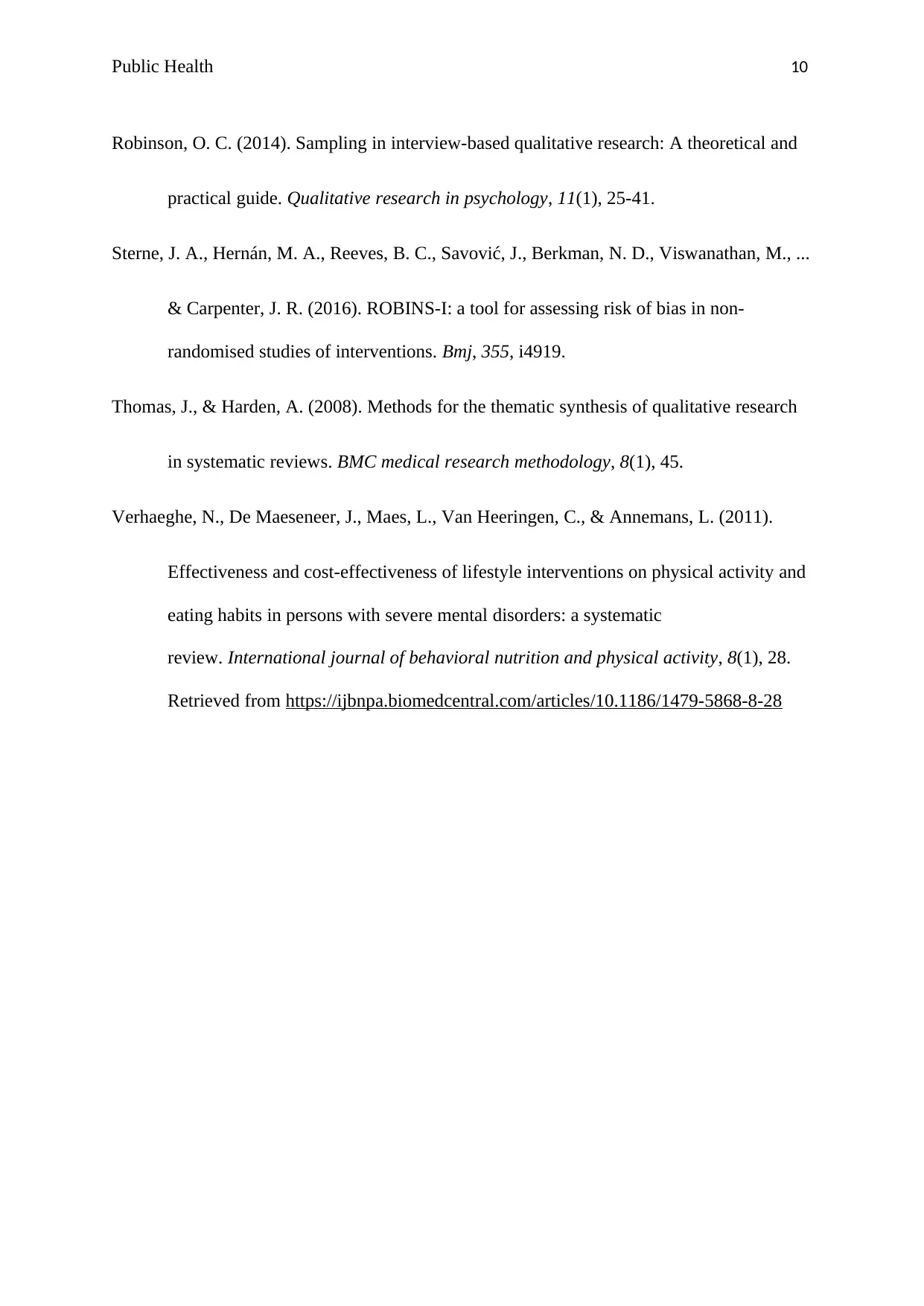
Public Health 10
Robinson, O. C. (2014). Sampling in interview-based qualitative research: A theoretical and
practical guide. Qualitative research in psychology, 11(1), 25-41.
Sterne, J. A., Hernán, M. A., Reeves, B. C., Savović, J., Berkman, N. D., Viswanathan, M., ...
& Carpenter, J. R. (2016). ROBINS-I: a tool for assessing risk of bias in non-
randomised studies of interventions. Bmj, 355, i4919.
Thomas, J., & Harden, A. (2008). Methods for the thematic synthesis of qualitative research
in systematic reviews. BMC medical research methodology, 8(1), 45.
Verhaeghe, N., De Maeseneer, J., Maes, L., Van Heeringen, C., & Annemans, L. (2011).
Effectiveness and cost-effectiveness of lifestyle interventions on physical activity and
eating habits in persons with severe mental disorders: a systematic
review. International journal of behavioral nutrition and physical activity, 8(1), 28.
Retrieved from https://ijbnpa.biomedcentral.com/articles/10.1186/1479-5868-8-28
Robinson, O. C. (2014). Sampling in interview-based qualitative research: A theoretical and
practical guide. Qualitative research in psychology, 11(1), 25-41.
Sterne, J. A., Hernán, M. A., Reeves, B. C., Savović, J., Berkman, N. D., Viswanathan, M., ...
& Carpenter, J. R. (2016). ROBINS-I: a tool for assessing risk of bias in non-
randomised studies of interventions. Bmj, 355, i4919.
Thomas, J., & Harden, A. (2008). Methods for the thematic synthesis of qualitative research
in systematic reviews. BMC medical research methodology, 8(1), 45.
Verhaeghe, N., De Maeseneer, J., Maes, L., Van Heeringen, C., & Annemans, L. (2011).
Effectiveness and cost-effectiveness of lifestyle interventions on physical activity and
eating habits in persons with severe mental disorders: a systematic
review. International journal of behavioral nutrition and physical activity, 8(1), 28.
Retrieved from https://ijbnpa.biomedcentral.com/articles/10.1186/1479-5868-8-28
1 out of 10
Your All-in-One AI-Powered Toolkit for Academic Success.
+13062052269
info@desklib.com
Available 24*7 on WhatsApp / Email
![[object Object]](/_next/static/media/star-bottom.7253800d.svg)
Unlock your academic potential
© 2024 | Zucol Services PVT LTD | All rights reserved.